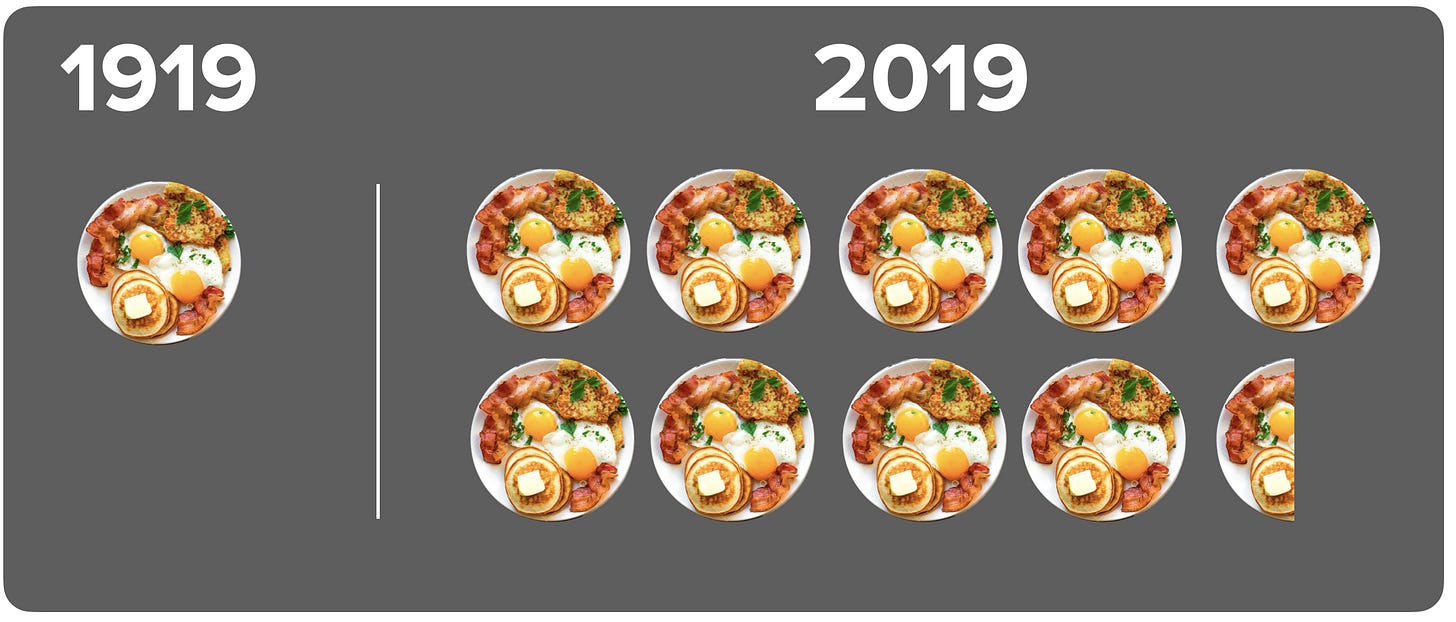Breakfast Bounty
Since 1919, the time price of breakfast has fallen by 93 percent. For the time required to buy one breakfast in 1919, you get 9.54 breakfasts today, an 854 percent increase in breakfast abundance.
We compared the prices of 12 breakfast items in 1919 to prices in 2019. The items included bacon, bread, butter, coffee, corn flakes, cream of wheat, eggs, ham, milk, oranges, rolled oats, and sugar. The 1919 prices were provided by the U.S. Bureau of Labor Statistics and the 2019 prices were collected by shopping at Walmart.
The money prices were then compared to the hourly compensation (wages and benefits) for an average blue-collar worker. The ratio of a money price divided by hourly compensation is called the time price, or the time required to earn the money to buy the item.
Shoppers in 1919 would spend around $4.18 to buy all 12 of these items. With compensation at 43 cents an hour, it would take them around 9.72 hours of work to stock up their breakfast pantry and icebox.
By 2019 the breakfast basket bill increased to $32.96. But hourly compensation increased to $32.36 so it took just over one hour to buy the same basket of 12 items.
Compared to workers in 1919, workers in 2019 have 8.7 “free” hours to do something else besides working to pay for breakfast. They can enjoy more leisure, learn a new skill, earn money to buy something else, or take a nap. In this sense, innovation gives us all more freedom.
Time prices decreased by an average of 93 percent with oranges dropping 73.5 percent and eggs dropping 97.2 percent. Personal resource abundance can be measured by comparing the two time prices. The 1919 time price divided by the 2020 time price indicates a value of 9.54 (9.72 hours ÷ 1.02 hours). For the time required to buy one basket of these breakfast items in 1919, you get 9.54 today. This is an 854 percent increase in personal breakfast abundance.
Breakfast and Population
This 854 percent increase in breakfast abundance occurred at the same time U.S. population increased 214 percent from 104.5 million to 328.2 million. Every one percent increase in population corresponded to a 4.0 percent increase in personal breakfast abundance.
You can measure the size of the resource abundance for a group by multiplying personal resource abundance by the size of the group. We call this value “population resource abundance.” Watching changes in this value over time indicates whether resources are becoming more or less abundant for a group, country, or the entire planet. Considering both growth in personal breakfast abundance and growth in population suggests that the total U.S. breakfast resource pie increased 2,896 percent.1 Every one percent increase in population corresponded to a 13.53 percent increase in the size of the U.S. breakfast basket. Breakfast resources have become what we call “superabundant,” increasing at a much faster rate than population growth.
When you enjoy breakfast tomorrow morning, take a moment to thank all those who have worked to make all of our breakfasts so bounteous.
Excerpt from our forthcoming book, The Age of Superabundance
[(9.54 x 3.14) -1]







From my experience of my fight to be efficient and have more time for myself, it has always ended with me getting even more work . as long as there is the "9-5" mentality (even tho i was working 10hr days , sometimes longer) i doubt that ill be able to escape this. So basically theres a cap to our free time for most people.